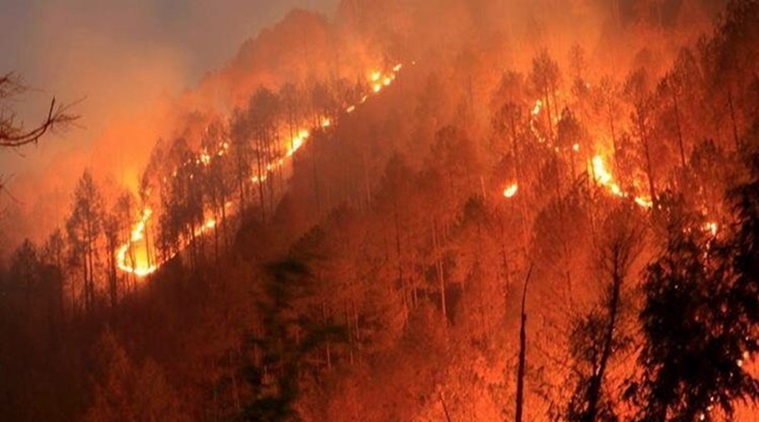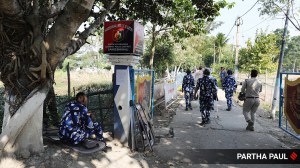- India
- International
Fire on the Mountain
Forest fires are a common occurrence in the hills of Uttarakhand, but this year, the magnitude has been much higher. The story of a village in Tehri Garhwal and the resistance of its women shows why the local community needs to be the first line of defence.
 A view of the Uttarakhand forest burning
A view of the Uttarakhand forest burning
It’s a sprawling village of over 2,000 residents, its houses making their way up the hill and facing the mountain ranges with a view that is the stuff of hotel advertisements. Behind Jardhar village, that lies nestled in the hills of the Henwal ghati in Tehri Garhwal, stands a forest of oak, rhododendron, chir pine and many more trees. It’s a reserved forest that villagers, mostly women, enter every day to collect dry wood and fodder. It’s a place of their work and also a place of rest, where they take occasional breaks, share some laughs and chat about their homes and their in-laws. It’s probably the first thing they see when they get up in the morning and the last before they retire indoors.
On the morning of April 20, Rajini Negi stepped out of her house to see the flames leap up from the forest and the smoke billowing out. “Along with some villagers, I rushed to the forest,” says Negi, head of the village’s Mahila Mangal Dal. On usual days, her work as head of the women’s group means resolving conflicts in the village, getting drunk husbands to mend their ways and getting women work, but, from the day the fire broke out near her village, for over a week, her role was transformed. She took on the fire that roared in her backyard. Her burnt hands still bear the scars. On the first day, she was the only woman fighting fire, but after that day, she was joined by a number of women who lived close to the forests. The men came, too, but the band of over 15 women was there every day at 7 in the morning, returning home only when the sun went down. “You should have seen our forests earlier. They were so beautiful,” she says, pointing to the withered trees on a slope where smoke from a still-smouldering log rises over the treetops. “It was so sad to see the burnt nests and eggs and the carcass of animals and birds when we went to the forests,” says Negi.
The fire came dangerously close to their fields and stones came tumbling onto the roof of a few houses. “After being in the smoke for so many days, I get headaches quite often. I couldn’t sleep for many days. Every time I would shut my eyes, all I could see was fire,” says Gaddu Devi. “From day two, there would be about 20 to 30 of us, including a few forest employees. We would eat at home in the morning before setting off and carry some food and water for the forest staff. The flames were leaping so high — the smoke would get into our eyes. Many of us are still having breathing problems,” says 45-year-old Magli Devi.
Forest fires are a common occurrence in the hills of Uttarakhand, but this year, the magnitude has been much higher. Puran Singh, an 85-year-old villager, says he has never seen a fire this intense in all these years. A bad monsoon, no winter rains and no intermittent April showers all contributed to conditions which fanned the fire. Some fires started from the reserved forests and some from villages where people set fire to their grassy slopes to ensure good grass the following year. The fire in the reserved forest, say residents of Jardhar, came creeping in through a village that lies on the other side of the forest.
[related-post]
Jardhar, like many other villages in Uttarakhand, has led the battle from the front, armed with nothing more sophisticated than a bunch of green branches to beat the fire down and a rake to clear the leaves. It has also highlighted the role of the community and the need and importance to involve them in issues that have an impact on their lives. The van panchayat of the block has now received Rs 20,000 to give to the villagers for their efforts in controlling the fire. “If we distribute it amongst everyone who came to douse the fire, no one’s share will be much, so we are thinking of keeping the sum and using it later for a project that will benefit everyone in the village,” says Rekha Devi, the 27-year-old pradhan of Jardhar. “We live near the forests, we are dependent on them — we get our firewood and fodder for our animals from here — if we won’t save them, who will? The forests are everything to us,” she says.

Women in Uttarakhand, like Gaura Devi of the Chipko movement, have played an important role in the conservation of forests in the hills. “Like in the cities, you go to the market for everything, we go to the forest,” chimes in another villager, Sushila Devi.
Jardhar’s attachment to its forest goes back a long way. Over three decades ago, the hills around the village had been denuded and the gram sabha decided to do something about it. Inspired by the Chipko movement, they formed a Van Suraksha committee to keep an eye on the forest. “We mobilised people. The samiti ensured no trees were felled or lopped for firewood and there were small fines imposed to deter violators. Native trees were planted and in about 10 years, the result could be seen,” says Vijay Jardhari. Oak, rhododendron, kaful, chir pine and many more species now cover the slopes above the village.
“There are about 90-95 species of trees in this 6-sq km forest, but the oak, whose leaves we use for fodder and manure, is no less than a kalpvriksh for us. Even now, we have two chowkidars from the village, who are paid Rs 300 each every month as honorarium to guard them,” he says.
Jardhari, who was associated with the Chipko movement and who now runs Beej Bachao Andolan, an organisation that seeks to promote traditional seeds and agricultural practices of the hills, says villagers are often the first line of defence when a fire breaks out. They also have traditional wisdom in dealing with crisis such as these. “You can bring in your helicopters and disaster forces, but you have to know how to deal with it. For instance, we know the best time to try and beat the fire down is in the morning till about 10 or so, and then later in the afternoon. In the intervening period, it gets very windy up in the hills. The fire goes up quickly in the wind and the sound of a fire as it rages is a very frightening one,” says Jardhari.
He points out that just putting out the fire is not a job full done. “If you need one person to douse the fire, you also need another to keep a check on it because even one chingari can spark another fire. A fire cannot be controlled without local people,” he says.
Nainital-based historian and writer Shekhar Pathak, who is the founder of People’s Association for Himalaya Area Research, too underlines the role of the people in protecting the forests. “Forests that come under van panchayats are often better protected than the rest, but these forests are less than 8 per cent in Uttarakhand. In 2009, seven people died in Gajwada village in Pauri trying to put out a fire that had spread to their panchayat forest from a neighbouring reserved forest,” he says. Of Uttarakhand’s 51,000 sq km area, 34,000 sq km is covered by forest, of which 30,000 sq km is administered by the forest department and 4,000 sq km is looked after by gram panchayats. “You have to involve people,” says Pathak.
Anil Joshi of the Dehradun-based Himalayan Environmental Studies & Conservation Organisation (HESCO) says the crux of the problem is the forest policy that has put such distance between the community and the forests. “The Forest Act of 1980 and the Forest Policy of 1988 made the forest department the manager of the forest and the people lost their rights over it. But as the recent incidents have shown, what can a few hundred officers and a few thousand employees do when a fire of such a scale comes along?” says Joshi. Six years ago, Joshi’s HESCO, along with the forest department, launched a project in Asarodi, digging ditches and making check dams as preventive measures against forest fires. “We made about 1,000 1×1 mt percolation tanks and 181 check dams. Whenever it rained, these tanks would hold the water, the moisture in the ground would be retained and there would be a perennial green cover of plants and saplings. All these factors help ensure that a fire doesn’t start from the ground. I have been trying to get the department to replicate these measures in other forest areas as well,” says Joshi. In fact, many share his concern over the growing alienation of people from the forests. With many villages emptied out of its menfolk in search of employment in cities, it is usually left to women to weather many crises alone.
But Peter Smetacek, who runs the Butterfly Research Centre in Bhimtal and is the author of Butterflies on the Roof of the World, says, the fires that are ravaging the hills these days are deliberate. “There are no natural fires in the Himalayas. Earlier, forest fires were accidental. People would traditionally set fire to grassy hillsides to get a good flush of grass after the rains. But these are deliberately set to help timber contractors and builders to clear the land of trees. These are acts of arson,” he says. With the recent arrests of people suspected of starting fire in forests, Smetacek hopes the right signal will go out. “If people saw the arsonists being punished, maybe, the next time, they will turn up to put out the fires. Since the time of the British, at the estate here, we had two gongs. Every time someone informed us of a fire, we would strike them and people would collect in no time. Now, barely anyone attempts to extinguish a fire,” he says.
The widening schism between the forest department and villagers often means the latter keep a distance from helping out in disasters such as the current one. The government employs fire watchers, on a daily payment basis from April to June, but many say they are often not paid on time. “The fire watchers are paid Rs 3,000 a month but often they are not paid on time. For instance, the fire watchers who worked in Binsar last year haven’t been paid yet. So, when the fire broke out there this year, they refused to go,” says Joshi. “Earlier, all you needed was someone to shout, ‘aag bujhon chalalo’ (let’s go to put out the fire) and everyone would come. Now, I find that it is still there only with the women,” says Jardhari.
But many still hold on to the hope that like the women of Jardhar rushed to their forests to save them, the next time, the call goes out, “aag bujhon chalalo”, it won’t go unattended.
WATCH INDIAN EXPRESS VIDEOS HERE
Apr 25: Latest News
- 01
- 02
- 03
- 04
- 05







































